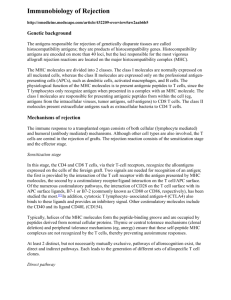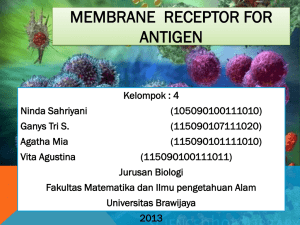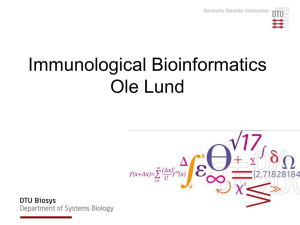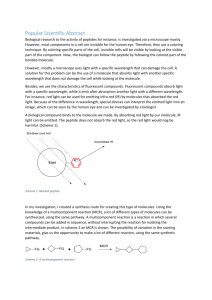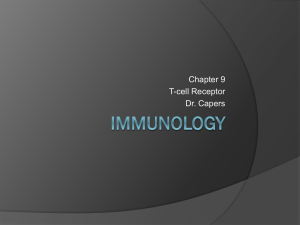Antigen Presentation
advertisement
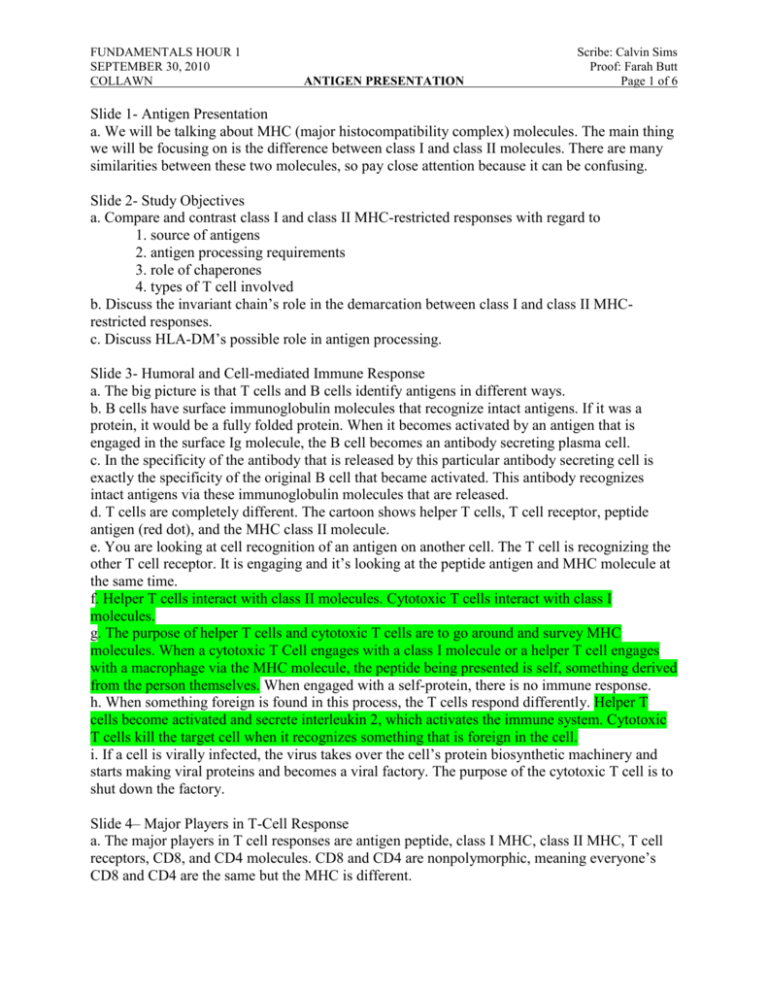
FUNDAMENTALS HOUR 1 SEPTEMBER 30, 2010 COLLAWN ANTIGEN PRESENTATION Scribe: Calvin Sims Proof: Farah Butt Page 1 of 6 Slide 1- Antigen Presentation a. We will be talking about MHC (major histocompatibility complex) molecules. The main thing we will be focusing on is the difference between class I and class II molecules. There are many similarities between these two molecules, so pay close attention because it can be confusing. Slide 2- Study Objectives a. Compare and contrast class I and class II MHC-restricted responses with regard to 1. source of antigens 2. antigen processing requirements 3. role of chaperones 4. types of T cell involved b. Discuss the invariant chain’s role in the demarcation between class I and class II MHCrestricted responses. c. Discuss HLA-DM’s possible role in antigen processing. Slide 3- Humoral and Cell-mediated Immune Response a. The big picture is that T cells and B cells identify antigens in different ways. b. B cells have surface immunoglobulin molecules that recognize intact antigens. If it was a protein, it would be a fully folded protein. When it becomes activated by an antigen that is engaged in the surface Ig molecule, the B cell becomes an antibody secreting plasma cell. c. In the specificity of the antibody that is released by this particular antibody secreting cell is exactly the specificity of the original B cell that became activated. This antibody recognizes intact antigens via these immunoglobulin molecules that are released. d. T cells are completely different. The cartoon shows helper T cells, T cell receptor, peptide antigen (red dot), and the MHC class II molecule. e. You are looking at cell recognition of an antigen on another cell. The T cell is recognizing the other T cell receptor. It is engaging and it’s looking at the peptide antigen and MHC molecule at the same time. f. Helper T cells interact with class II molecules. Cytotoxic T cells interact with class I molecules. g. The purpose of helper T cells and cytotoxic T cells are to go around and survey MHC molecules. When a cytotoxic T Cell engages with a class I molecule or a helper T cell engages with a macrophage via the MHC molecule, the peptide being presented is self, something derived from the person themselves. When engaged with a self-protein, there is no immune response. h. When something foreign is found in this process, the T cells respond differently. Helper T cells become activated and secrete interleukin 2, which activates the immune system. Cytotoxic T cells kill the target cell when it recognizes something that is foreign in the cell. i. If a cell is virally infected, the virus takes over the cell’s protein biosynthetic machinery and starts making viral proteins and becomes a viral factory. The purpose of the cytotoxic T cell is to shut down the factory. Slide 4– Major Players in T-Cell Response a. The major players in T cell responses are antigen peptide, class I MHC, class II MHC, T cell receptors, CD8, and CD4 molecules. CD8 and CD4 are nonpolymorphic, meaning everyone’s CD8 and CD4 are the same but the MHC is different. FUNDAMENTALS HOUR 1 SEPTEMBER 30, 2010 COLLAWN ANTIGEN PRESENTATION Scribe: Calvin Sims Proof: Farah Butt Page 2 of 6 b. CD8 provides specificity in cytotoxic T cells recognizing class I and CD4 provides specificity in Helper T cells recognizing class II molecules. Slide 5- T Lymphocytes and Macrophage a. T lymphocytes contain a very large contact area and hundreds of receptors are engaging with MHC molecules at any one time. b. The purpose of doing this is to make sure nothing is foreign is present. Most of the time, there are no problems and T cells continue to move along. Slide 6- Types of t cells a. Cytotoxic T cells (CTLs) 1. Kill virally infected cells 2. Kill cells containing cytosolic bacteria 3. Kill tumor cells All the antigens that cytotoxic T cells recognize are proteins that were synthesized in the cell. They are referred to as endogenous proteins. b. Inflammatory T cells (TH1) 1. Activate macrophages to kill intracellular bacteria c. Helper T cells (TH2) 1. Activate B cells to make antibody Slide 7- Schematic Diagrams of MHC class I and class II Molecules a. Class I and Ii molecules look similar but have different functions and are arranged differently. b. The peptide binding sites are presented to the T cell receptors. c. The polymorphic part of class I molecules is the alpha chain. Most residues that are important in binding the peptides are those that are different from person to person. d. MHC molecules are different from person to person and most differences are in amino acids, which affect the peptide binding site. e. β2 microglobulin molecules are identical in everyone. Slide 8- MHC class I (top view) a. This is the view of what a T cell receptor would see before engaging the complex. The structure contains a beta sheet with two alpha helices above it (forming a shape similar to a mouth). The peptide binds in the region that looks like a mouth. The peptide is not covalently associated with MHC I or II. The peptide binding is from hydrophobic and ionic interactions. Slide 9 a. The peptide binding domain for class I molecules are α1 and α2. The peptide binding domain for class Ii molecules are α1 and β1. b. The general size of a peptide class I molecule is about 8-10 amino acids. The sizes of class II molecules are larger than those of class I. Slide 10- Major Histocompatability Complex a. Class I molecules contain HLA-A, HLA-B, and HLA-C, which have to deal with all the antigen recognition in terms of T cell recognition and don’t have the same type of diversity as we do for antigens. FUNDAMENTALS HOUR 1 SEPTEMBER 30, 2010 COLLAWN ANTIGEN PRESENTATION Scribe: Calvin Sims Proof: Farah Butt Page 3 of 6 b. We have six class I molecules: 2 HLA-A, 2 HLA-B, and 2 HLA-C. The HLA molecules can be the same as someone else’s HLA molecule, but it mostly will be different. Everyone’s HLA molecules can have different numbers of amino acids in its chain as well. c. Class II molecules: HLA-DP, HLA-DQ, and HLA-DR d. There are six different versions of class I as well. These molecules have peptide binding sites that only have alpha chains. e. Class II has more diversity because it has alpha and beta chains and creates more combinations when put together (over 2000 combinations). Slide 11- HLA-DR1 and HLA-A2 a. HLA-DR1 is class II. b. HLA-A2 is class I. c. The image is oriented from top view and illustrates the cartoon in slide 8. d. Although the 2 structures shown are different, the peptide binding site is similar. Slide 12- MHC class I a. The image is shown from the view of T cell receptor. b. The peptide is shown in the orangish-red color. c. The white area is the alpha helix. d. The blue area is the beta sheet. e. When MHC binds with the peptide, this is the only peptide the MHC molecule will ever bind to. The binding is from hydrophobic and ionic interactions. f. The goal of MHC is to get to the cell surface and present the peptide so that the T cell will know whether the peptide is self or foreign. Slide 13- MHC class II a. The image shows the alpha and beta chain forming the binding site. b. The peptide looks much better, which is necessary for peptide to fit in the “mouth” of the MHC class II molecule. Slide 14- Anchor Residues for MHC class I peptides a. In the past, one goal was to find the nature of MHC. b. The MHC molecule was isolated and the peptide was removed, which was not easy to do because of the tight peptide bond. c. Most amino acids in the molecule didn’t match but what seemed to be consistent was the length of the chain and the hydrophobic end of the molecule, which was possibly by an enzyme. d. MHC has the ability to bind many different peptides. e. MHC in different individuals may differ as well, which may determine how susceptible one is to an illnesses. Slide 15- Conformation of Peptides Bound to MHC I a. The length of the chain seemed to be important (about 9 residues). b. Referred to anchor residues, where two or three positions seemed to also be important. The Cterminus always seemed to have a hydrophobic ending. c. There was also a little specificity. d. All these factors are important for the binding of the peptide FUNDAMENTALS HOUR 1 SEPTEMBER 30, 2010 COLLAWN ANTIGEN PRESENTATION Scribe: Calvin Sims Proof: Farah Butt Page 4 of 6 Slide 16- Solvent accessible area of H-2Kb a. The immune system tries to determine self vs foreign. b. It uses an affinity interaction to determine this. c. If the affinity of T cell contact was high, there was a T cell response. If the affinity was low, there was no response. d. There is no in between point, it either responds or it doesn’t. e. It is important that T cell doesn’t make a mistake in over responding because if so, you have an autoimmune disease. f. When the peptide is bound, the mouth forms around it so that it binds tightly. g. The T cell receptors look at the whole surface and see the surface changes with every peptide that binds. It looks at how the surface has been affected to tell if the peptide is self or foreign. Slide 17- Anchor Resides for MHC class II peptides a. When doing the same analysis of class II as that done to class I, it was found that the size of molecule didn’t matter, the end of the molecule didn’t have to be hydrophobic, and it required low specificity. b. The binding site of class II molecules can accommodate things spilling out the mouth in both directions because it is larger than the binding site of class I molecules. c. There are not many similarities present, however, it binds anyways. The ends can be hydrophobic or hydrophilic and it can have different amino acids. d. Many different peptides can bind to class II molecules. Slide 18- Antigen Processing is Necessary for Helper T cell Activation a. You have an Antigen Presenting Cell (APC) and helper T cell. This is a helper T cell assay. b. The APC can be cultured to be a macrophage. They are cultured in a tissue covered flask. c. What does it take to activate a helper T cell? Proliferation of the T cell or secretion of Interleukin 2. d. If T cell engages with a class II molecule and recognizes a foreign antigen, it will become active, proliferate, and secrete Interleukin 2. e. You can take APC and incubate cells with the intact antigen, and after an hour, you have fixed cells with para-formaldehyde, which fixes the surface of the APC. This stops the entering and exiting of the cells. If you then incubate with helper T cells, you get an immune response. f. (Exp 2) If you fix the APC first and incubate it with intact antigen, you get no immune response. g. This means the antigen cell was viable and had to process that antigen into peptides to activate the helper T cells. h. A third possible experiment would be to fix the cell first, except this time, take the antigens ourselves and undergo a trypsin digest of that cell, which breaks it into fragments. We then add the peptide fragments to fixed antigen presenting cells and in this case, activate the helper t cells. i. In the 2nd experiment, the APC took the peptides and put peptides on class II molecules. In the 3rd experiment, we circumvented that by doing it ourselves. Slide 19- Antigen-Presenting Cells (MHC Class II – Positive Cells) a. The class II molecules (HLA-DR, HLA-DP, and HLA-DR) are found on B cells, dendritic cells, and macrophages. FUNDAMENTALS HOUR 1 SEPTEMBER 30, 2010 COLLAWN ANTIGEN PRESENTATION Scribe: Calvin Sims Proof: Farah Butt Page 5 of 6 b. The molecules can be induced on other cell types, but this is usually not good to do. Slide 20- Target Cells (MHC Class I- positive cells) a. Class I molecules are expressed on all nucleated cells. b. All cells, except blood cells. Slide 21- Degradation of Intracellular Proteins a. The proteasome is a large multiunit complex that degrades all proteins of the cell. b. There is a mechanism that indicates which proteins need to be degraded. Placing a ubiquitin tag onto a protein indicates that it needs to be degraded. A multiubiquitin tag is a signal for this proteolytic degradation. c. The proteasome degrades the proteins in the peptides. Slide 22- Transporter associated with Antigen Processing a. The ATP Pump takes the peptides that have been degraded by the proteasome and pumps them into the lumen of the ER and becomes associated with the class I molecule. Most of the material degraded by the proteasome is utilized in protein synthesis. Slide 23- Generation of Peptide-class I MHC Complexes a. We have protein that is ubiquitin modified by the proteasome, which clips the protein into peptides. Most of the material is degraded into amino acids, but the sampling becomes a substrate for this transporter (TAP) delivers the peptides into the ER. Peptides become associated with claa I molecules as it is being synthesized. This is different in class I and class II molecules. Chaperones that help with this are Tapesin, Calreticulin, and Calnexin. They ensure that alpha chain, beta sheet, and peptides are associated and are in place. If the peptide does not engage with the class I MHC molecule, then the complex is not complete and it does not leave the ER. Slide 24- Demarcation between MHC class I and class II Processing Pathway a. Class I has an endogenous pathway, meaning it is synthesized within the cell. b. MHC class I is associated with endogenous antigens. c. MHC class II has an exogenous pathway is therefore associated with exogenous antigens. d. The big picture of Class I- Some endogenous antigen (virus protein) is synthesized in the cell. Some of that material becomes substrate for the proteasome and clips it into peptide fragments, where it is transported through the ATP pump for processing. The fragments then approach the chaperones, which associate the peptide with the alpha helix and beta sheet with each other. The MHC then goes to the Golgi complex and onto the cell surface where it forms it biological function (Identifying self and foreign proteins). e. It takes about 12 hours for this to take place, so the half-life of the protein is 12 hours. f. T cells continually survey cells and if something foreign is found, cytotoxic T kills the cell. g. The big picture of Class II- This molecule has alpha chains, a beta chain, as well as, an invariant chain. The newly synthesized MHC II does not have an antigen associated with it because the invariant chain blocking the peptide binding site. h. The invariant chain is important because it blocks the binding site; preventing peptides associated with class I molecules from being associated with class II molecles. It also signals molecules to the late endosome lysosomal compartment. FUNDAMENTALS HOUR 1 SEPTEMBER 30, 2010 COLLAWN ANTIGEN PRESENTATION Scribe: Calvin Sims Proof: Farah Butt Page 6 of 6 i. In the lysosomal compartments, you have lysosomal hydrolases that are proteases and are responsible for degradation of class II antigens. j. This is the exogenous pathway, which means the antigens are coming in from the outside via endocytosis or phagocytosis. It varies depending on the cell type. k. So we take the antigens in and they mate in the late endogenous lysosomal compartment, which degrades antigen s to peptides as well as degrading the invariant chain. The alpha and beta chains are resistant to these proteases, which is important because it allows entire process to work successfully. Slide 25- Cytosolic and Endocytic Pathway for Antigen Processing a. Class I (endogenous) – Endogenous antigens → Ubiqitin modified→ substrate from proteasome becomes peptides within the cytosol→ transported into the lumen of the ER→ Becomes associated with class I molecules by chaperones→ go out to cell surface. b. Class II (exogenous) – Exogenous antigens→ come through via endocytosis or phagocytosis→ goes into endocytic/lysosomal compartments→ proteases degrade antigen to peptides→ peptide becomes associated with class II. Slide 26- Assembly of MHC class II Molecules a. Here’s the assembly of the class II molecule. Here’s the alpha and beta chain. Here’s the invariant chain. These things become associated in the ER. B .Once this MHC class II invariant chain delivered this to the lysosomal compartment, this part of the invariant chain is removed. The fragment that was sitting there is still there. HLA-DM is a chaperone. It looks like it would be a class II molecule in terms of sequence. That’s why they gave it a name like this but they found out that in fact it doesn’t do that. We don’t know how HLA-DM works. It doesn’t seem to bind peptide itself but it somehow facilitates the exchange of this CLIP for a peptide antigen. Without HLA-DM you have cell lines that lack HLA-DM what you have is a class II molecule sitting on the cell surface that has CLIP in it. So you absolutely have to have HLA-DM to do this exchange reaction. c.HLA-DO is another chaperone. I don’t care that you know this but it’s on here and someone always asks about it. It basically modulates the activity of HLA-DM. Slide 27- Study Objectives a. Compare and contrast class I and class II MHC-restricted responses with regard to 1. source of antigens 2. antigen processing requirements 3. role of chaperones 4. types of T cell involved b. Discuss the invariant chain’s role in the demarcation between class I and class II MHCrestricted responses. c. Discuss HLA-DM’s possible role in antigen processing. [End 45:52 mins]

